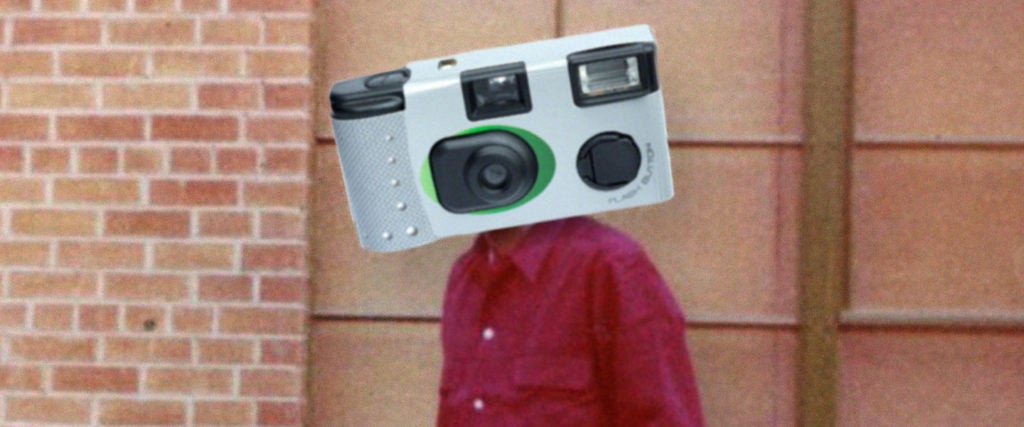In the latest edition of damn, young people make me feel old, disposable cameras are now digital: New photo editing app Dispo renders pics in the appearance of a disposable camera that develops photos over 24 hours, meaning you have to wait to see your snaps. How novel!
Influencer David Dobrik, who is behind the app, explained to the New York Times that he wanted the experience of nostalgically looking back the morning after a night out without the stress of having to perfectly edit a photo for Instagram while hungover. “You never looked at the picture, you never checked the lighting. You just went on with your day, and in the morning you got to relive it,” Dobrik said of his love for old-school disposable cameras.

Digital film photography as seen on Dispo looks like a mashup of early-2010s-era Instagram and Tumblr non-selfie aesthetics, with the authenticity of modern unfiltered posting. And handily, Dispo does all the editing (to look like the photo wasn’t edited) for you. It’s a sign that the tech industry is finally investing in social media’s ongoing film photography revival, and it makes some sense from a consumer standpoint — why pay for a disposable Kodak camera when you could just let Big Tech have access to your data in exchange for free “film” photos? It seems to be working, too: The beta version of Dispo maxed out its 10,000-user count, and the app already has a reported $200 million valuation.
For years now, influencers and artsy everyday posters have been pivoting away from overly edited photos in favor of impromptu — or perhaps painstakingly edited to look unedited — photography. “It’s more of a movement within the micro- and macro-influencer space,” Chrissy Abram, influencer marketing manager at social media marketing platform Later, says. “Some big brands have hopped on it, but we’ve yet to see it be a mainstream trend.”
For the everyday online poster, there’s long been a certain personality associated with the type of guy who posts film photos online — or, more accurately, photos edited with a heavy grain to look timeless. Let’s call them Dispo boys — a term I coined alongside Vox reporter Terry Nguyen in her Gen Yeet newsletter last week, which was later cemented by a mention in the New York Times. Dispo boys are a categorization that exists beyond just guys on Dobrik’s app, though, and unlike influencers, they don’t post photos of their faces. Instead, they can be found on Instagram, TikTok and Tumblr posting photos of their hometown’s abandoned storefront or plastic bags as if they’re performing the soliloquy from American Beauty. They are depressed, obviously, but unlikely to be in therapy. “I’m sure to the average person, the Dispo boy’s feed just looks clean and aesthetic and a little dark,” Nguyen says.

When zoomed in on, this vibe reads as more than just intentionally grainy photos of buildings. Nguyen says the stereotypical Dispo boy is consumed by film, alt-R&B music, mainstream pop culture not yet considered mainstream, thrift shops (or thrifting apps) and road trips. “That’s just the vibe I get, and I have no idea whether it’s accurate or not,” she says. “But so far, I haven’t been entirely wrong.”
Dispo boys, then, are a continuation of the alt-male aesthetics of the past: film bros, softbois, e-boys, those dudes with mustache finger tattoos. There’s even a subset of the Dispo boy fixated on nature and architecture photography as shot on an old iPhone 7, but don’t be mistaken, this isn’t for financial reasons: Increasingly, owning old iPhones is a marker that you’re not a hustle bro wrapped in the capitalist tentacles of Apple. You’re not swayed by gentrification, Bitcoin and/or Elon Musk. To own an iPhone 7 for aesthetic purposes today is akin to owning a Crosley record player from Urban Outfitters or shopping on Depop — it’s performatively vintage and “thoughtful.”
The easiest comparison to Dispo boys is probably VSCO girls, named after another photo editing app. However, VSCO girls are younger and primarily Gen Z teenagers (who can de-age Robert De Niro better than Martin Scorsese). They stereotypically have a penchant for TikTok, cool-tone photo filters and a love for scrunchies. Dispo boys, however, skew older. “These are the twenty- and thirtysomething guys whose online vibe is artsy, slightly rugged or ‘alt,’ as one might say,” Nguyen writes in Gen Yeet.
Dispo boys, because they are male, aren’t scrutinized as intensely as VSCO girls. While VSCO girls are lambasted for being “basic” with their Hydro Flasks and computer stickers, Dispo boys often receive praise for their photographic “grittiness” — their grainy filters imply they, too, are nuanced and mature, an old soul with irl pixelation.
That said, like any of the stereotypical categorizations of online personality, the idea of a Dispo boy is largely circumstantial and surface-level. He certainly would balk at the idea of you confining him to a labeled aesthetic. He also may not be male — often, these gendered labels of online “brands” eliminates the presence of content shared online by artists of all backgrounds.
So take these terminologies with a heavy grain of salt, because the Dispo guy might not be as, well, filtered for pleasure as he seems. Just like the type of camera they use, Dispo boys are disposable — the only thing worth saving is themselves from their own self-obsession.

